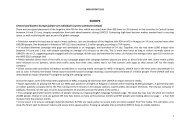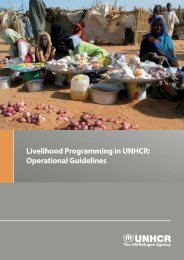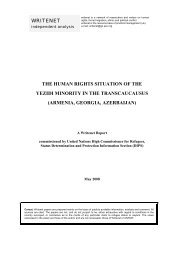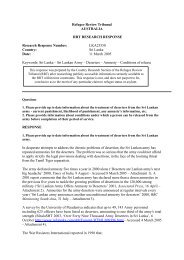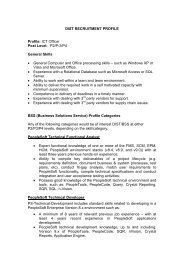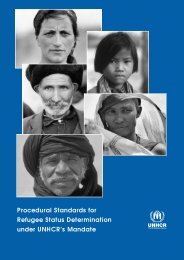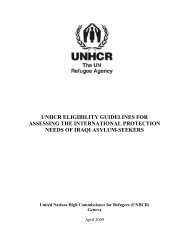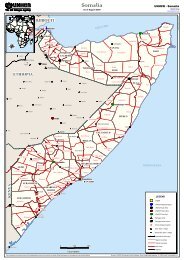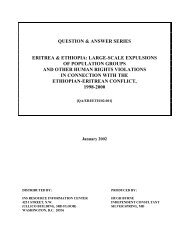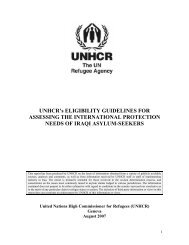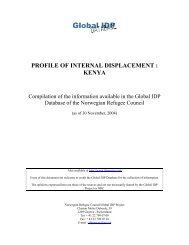CONCLUSIONS ADOPTED BY THE EXECUTIVE ... - UNHCR
CONCLUSIONS ADOPTED BY THE EXECUTIVE ... - UNHCR
CONCLUSIONS ADOPTED BY THE EXECUTIVE ... - UNHCR
Create successful ePaper yourself
Turn your PDF publications into a flip-book with our unique Google optimized e-Paper software.
2007 (Executive Committee—58 th Session)<br />
survivors of violence, in particular sexual and gender-based violence and other forms of abuse and<br />
exploitation; children who get married under the age specified in national laws and/or children in<br />
forced marriages; children who are or have been associated with armed forces or groups; children in<br />
detention; children who suffer from social discrimination; children with mental or physical disabilities;<br />
children living with or affected by HIV and AIDS and children suffering from other serious diseases;<br />
and children out of school;<br />
(d) Recognizes the challenges involved in identifying children at heightened risk as they are frequently less<br />
visible than adults and may not have the opportunity or feel able to report protection incidents, particularly if<br />
these occur in the private domain and/or are associated with social stigmas or taboos; acknowledges the need to<br />
provide children access to adults with expertise in age-appropriate and gender-sensitive interviewing and<br />
communication skills to ensure that children's views are taken into account and their needs and protection risks<br />
are adequately identified and responded to;<br />
(e) Recognizes that individual, careful and prompt registration of children can be useful for States, <strong>UNHCR</strong> and<br />
other relevant agencies and partners in identifying children at heightened risk;<br />
(f) Recognizes that the systematic collection and analysis of age- and sex-disaggregated data, and of data on<br />
children with specific needs, such as unaccompanied and separated children, can be useful for States, <strong>UNHCR</strong><br />
and other relevant agencies and partners in identifying children at heightened risk;<br />
Prevention, response and solutions<br />
(g) Recommends that States, <strong>UNHCR</strong> and other relevant agencies and partners work in close collaboration to<br />
prevent children from being put at heightened risk, and respond, as necessary, through the general prevention,<br />
response and solution measures listed non-exhaustively below:<br />
i. Within the framework of the respective child protection systems of States, utilize appropriate<br />
procedures for the determination of the child's best interests which facilitate adequate child<br />
participation without discrimination: where the views of the child are given due weight in accordance<br />
with age and maturity; where decision makers with relevant areas of expertise are involved; and where<br />
there is a balancing of all relevant factors in order to assess the best option;<br />
ii. In the case of <strong>UNHCR</strong>, conduct best interests determinations respecting child protection systems of<br />
States in cooperation with other relevant agencies and partners;<br />
iii. Incorporate needs and rights of children into early warning mechanisms, alerts and contingency plans,<br />
and ensure integration of child-based risk analysis into inter-agency assessments relevant to children at<br />
risk and development cooperation strategies and plans;<br />
iv. Establish confidential, accessible and child and gender-friendly complaints and referral systems, in<br />
coordination with national authorities when necessary, with clear roles for receiving, referring and<br />
addressing complaints from or about a child while ensuring the safety of the child, and for managing<br />
case files; children should be adequately informed about the availability of complaint and remedial<br />
mechanisms;<br />
v. Promote the implementation of mechanisms for monitoring the protection of children at risk,<br />
particularly of those in alternative care arrangements;<br />
vi. Strengthen or promote the establishment of child protection committees, as appropriate, with equal and<br />
meaningful participation of girls and boys;<br />
vii. Facilitate access to administrative or judicial procedures of States that are in accordance with their<br />
international obligations and that allow for the prosecution of perpetrators of crimes committed against<br />
children, and in which decisions on whether a child should be separated from her or his abusive or<br />
negligent parents or caretakers are made based on a determination of the child's best interests;<br />
viii. Develop child and gender-sensitive national asylum procedures, where feasible, and <strong>UNHCR</strong> status<br />
determination procedures with adapted procedures including relevant evidentiary requirements,<br />
prioritized processing of unaccompanied and separated child asylum-seekers, qualified free legal or<br />
other representation for unaccompanied and separated children, and consider an age and gendersensitive<br />
application of the 1951 Convention through the recognition of child-specific manifestations<br />
and forms of persecution, including under-age recruitment, child trafficking and female genital<br />
mutilation;<br />
ix. Ensure that age assessments are only carried out in cases when a child's age is in doubt, and take into<br />
account both the physical appearance and the psychological maturity of the individual; that they are<br />
192




